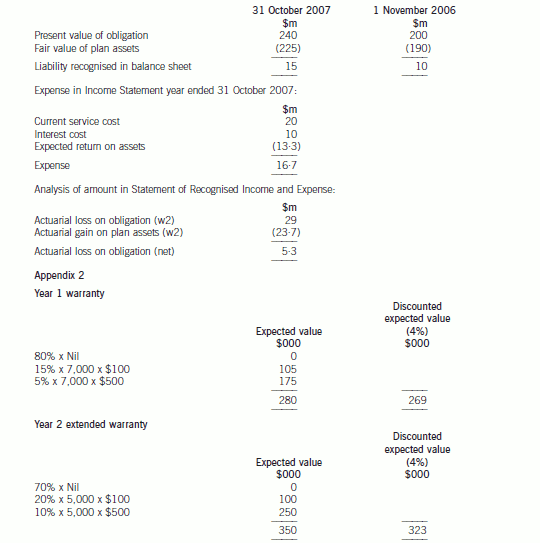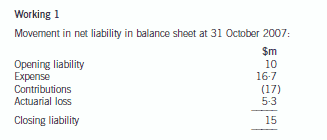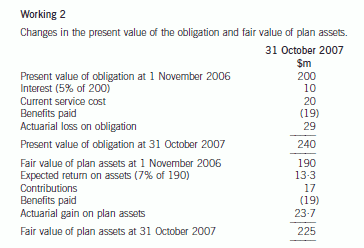江苏省2020年ACCA国际会计师报名入口及报名流程~
发布时间:2020-01-09
各位“资深”ACCAer们,提醒一下大家,目前正处于2020年3月份ACCA考试的常规报名阶段,没有报名的同学请抓紧时间报名哦~ 什么?作为“资深”ACCAer的你竟然忘记了ACCA报名的流程是什么样的?那么接下来,51题库考试学习网将告诉大家关于ACCA考试报名流程的具体操作步骤,萌新建议收藏哦~
第一步:登录ACCA官方网站:https://www.accaglobal.com/africa/en.html,点击myACCA(在这里温馨提示大家,因为ACCA称之为国际注册会计师,因此报名的流程是全英文的)

第二步:输入你的ACCA账号和密码,点击SIGN in to Myacca

第三步:在左侧导航栏中找到“EXAM ENTRY”,点击进入

第四步:点击 Book your
exams now

第五步:点击 Add
an exam

第六部(这个步骤相对比较复杂,各位同学们注意哟!):分别选择地点、时间、报考科目




第七步:在下图红色画圈处点击方框处打钩,之后点击Proceed to Payment支付考试费用

最后一步:有VISA双币卡的同学可以用VISA卡支付,没有VISA卡的同学可以使用支付宝支付(Alipay)

“资深”ACCAer们看完上面的科目报名缴费流程,是不是回忆起来了呀?“新手”ACCAer们是否对报名缴费流程有了一定的了解呢?51题库考试学习网在这里想告诉大家:毕竟报考ACCA考试的费用不算一个小数目,请同学们报考时谨慎考虑,一旦报名的那一刻就一定要坚持下来,学习的路程注定是孤独的,要坚定自己的内心,持之以恒地学习下去,加油,同学们~
下面小编为大家准备了 ACCA考试 的相关考题,供大家学习参考。
(b) (i) Discusses the principles involved in accounting for claims made under the above warranty provision.
(6 marks)
(ii) Shows the accounting treatment for the above warranty provision under IAS37 ‘Provisions, Contingent
Liabilities and Contingent Assets’ for the year ended 31 October 2007. (3 marks)
Appropriateness of the format and presentation of the report and communication of advice. (2 marks)
(b) Provisions – IAS37
An entity must recognise a provision under IAS37 if, and only if:
(a) a present obligation (legal or constructive) has arisen as a result of a past event (the obligating event)
(b) it is probable (‘more likely than not’), that an outflow of resources embodying economic benefits will be required to settle
the obligation
(c) the amount can be estimated reliably
An obligating event is an event that creates a legal or constructive obligation and, therefore, results in an enterprise having
no realistic alternative but to settle the obligation. A constructive obligation arises if past practice creates a valid expectation
on the part of a third party. If it is more likely than not that no present obligation exists, the enterprise should disclose a
contingent liability, unless the possibility of an outflow of resources is remote.
The amount recognised as a provision should be the best estimate of the expenditure required to settle the present obligation
at the balance sheet date, that is, the amount that an enterprise would rationally pay to settle the obligation at the balance
sheet date or to transfer it to a third party. This means provisions for large populations of events such as warranties, are
measured at a probability weighted expected value. In reaching its best estimate, the entity should take into account the risks
and uncertainties that surround the underlying events.
Expected cash outflows should be discounted to their present values, where the effect of the time value of money is material
using a risk adjusted rate (it should not reflect risks for which future cash flows have been adjusted). If some or all of the
expenditure required to settle a provision is expected to be reimbursed by another party, the reimbursement should be
recognised as a separate asset when, and only when, it is virtually certain that reimbursement will be received if the entity
settles the obligation. The amount recognised should not exceed the amount of the provision. In measuring a provision future
events should be considered. The provision for the warranty claim will be determined by using the expected value method.
The past event which causes the obligation is the initial sale of the product with the warranty given at that time. It would be
appropriate for the company to make a provision for the Year 1 warranty of $280,000 and Year 2 warranty of $350,000,
which represents the best estimate of the obligation (see Appendix 2). Only if the insurance company have validated the
counter claim will Macaljoy be able to recognise the asset and income. Recovery has to be virtually certain. If it is virtually
certain, then Macaljoy may be able to recognise the asset. Generally contingent assets are never recognised, but disclosed
where an inflow of economic benefits is probable.
The company could discount the provision if it was considered that the time value of money was material. The majority of
provisions will reverse in the short term (within two years) and, therefore, the effects of discounting are likely to be immaterial.
In this case, using the risk adjusted rate (IAS37), the provision would be reduced to $269,000 in Year 1 and $323,000 in
Year 2. The company will have to determine whether this is material.
Appendix 1
The accounting for the defined benefit plan is as follows:



(b) As a newly-qualified Chartered Certified Accountant, you have been asked to write an ‘ethics column’ for a trainee
accountant magazine. In particular, you have been asked to draft guidance on the following questions addressed
to the magazine’s helpline:
(i) What gifts or hospitality are acceptable and when do they become an inducement? (5 marks)
Required:
For each of the three questions, explain the threats to objectivity that may arise and the safeguards that
should be available to manage them to an acceptable level.
NOTE: The mark allocation is shown against each of the three questions above.
(b) Draft guidance
(i) Gifts and hospitality
Gifts and hospitality may be offered as an inducement i.e. to unduly influence actions or decisions, encourage illegal or
dishonest behaviour or to obtain confidential information. An offer of gifts and/or hospitality from a client ordinarily gives
rise to threats to compliance with the fundamental principles, for example:
■ self-interest threats to objectivity and/or confidentiality may be created if a gift from a client is accepted;
■ intimidation threats to objectivity and/or confidentiality may arise through the possibility of such offers being made
public and damaging the reputation of the professional accountant (or close family member).
The significance of such threats will depend on the nature, value and intent behind the offer. There may be no significant
threat to compliance with the fundamental principles if a reasonable and informed third party would consider gifts and
hospitality to be clearly insignificant. For example, if the offer of gifts or hospitality is made in the normal course of
business without the specific intent to influence decision making or to obtain information.
If evaluated threats are other than clearly insignificant, safeguards should be considered and applied as necessary to
eliminate them or reduce them to an acceptable level.
Offers of gifts and hospitality should not be accepted if the threats cannot be eliminated or reduced to an acceptable
level through the application of safeguards.
As the real or apparent threats to compliance with the fundamental principles do not merely arise from acceptance of
an inducement but, sometimes, merely from the fact of the offer having been made, additional safeguards should be
adopted. For example:
■ immediately informing higher levels of management or those charged with governance that an inducement has
been offered;
■ informing third parties (e.g. a professional body) of the offer (after seeking legal advice);
■ advising immediate or close family members of relevant threats and safeguards where they are potentially in
positions that might result in offers of inducements (e.g. as a result of their employment situation); and
■ informing higher levels of management or those charged with governance where immediate or close family
members are employed by competitors or potential suppliers of that organisation.
5 The directors of Quapaw, a limited liability company, are reviewing the company’s draft financial statements for the
year ended 31 December 2004.
The following material matters are under discussion:
(a) During the year the company has begun selling a product with a one-year warranty under which manufacturing
defects are remedied without charge. Some claims have already arisen under the warranty. (2 marks)
Required:
Advise the directors on the correct treatment of these matters, stating the relevant accounting standard which
justifies your answer in each case.
NOTE: The mark allocation is shown against each of the three matters
(a) The correct treatment is to provide for the best estimate of the costs likely to be incurred under the warranty, as required by
IAS37 Provisions, contingent liabilities and contingent assets.
声明:本文内容由互联网用户自发贡献自行上传,本网站不拥有所有权,未作人工编辑处理,也不承担相关法律责任。如果您发现有涉嫌版权的内容,欢迎发送邮件至:contact@51tk.com 进行举报,并提供相关证据,工作人员会在5个工作日内联系你,一经查实,本站将立刻删除涉嫌侵权内容。
- 2020-01-09
- 2020-03-01
- 2020-01-10
- 2020-01-10
- 2020-01-08
- 2020-01-10
- 2020-03-07
- 2020-05-21
- 2020-01-30
- 2020-01-10
- 2020-04-04
- 2020-01-09
- 2020-02-29
- 2020-01-09
- 2021-09-12
- 2020-05-21
- 2020-01-09
- 2020-01-08
- 2020-01-10
- 2020-01-10
- 2020-03-21
- 2020-04-15
- 2020-03-08
- 2019-07-21
- 2020-01-14
- 2019-07-21
- 2020-04-24
- 2020-02-28
- 2020-08-13
- 2019-07-21